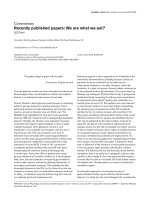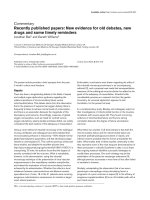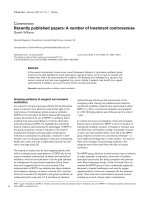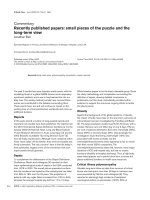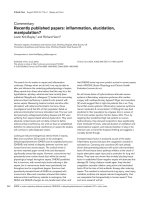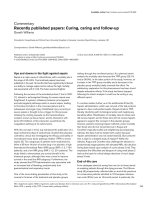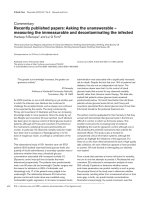Báo cáo khoa học: "Recently published papers: Out with the old and in with the new … then something new for the old" pptx
Bạn đang xem bản rút gọn của tài liệu. Xem và tải ngay bản đầy đủ của tài liệu tại đây (40.53 KB, 3 trang )
238
ARF = acute respiratory failure; COAD = chronic obstructive airways disease; FiO
2
= fractional inspired oxygen; GCS = Glasgow Coma Scale; ICU =
intensive care unit; NiPPV = noninvasive positive pressure ventilation; PaO
2
= arterial oxygen tension; rVIIa = recombinant activated factor VII.
Critical Care June 2005 Vol 9 No 3 Carbert and Venn
Abstract
New therapies are challenging older, established practices. One
recently published report shows us that we may be able to avoid
endotracheal intubation in patients with a reduced level of
consciousness. Recombinant activated factor VII is proving to be
useful in many coagulation disorders, and intracerebral haemor-
rhage can be added to this list. Homeopathy, in the form of
potassium dichromate, shows promise as a new treatment for
excessive tracheal secretions. Rotation protocols for antibiotics
have been evaluated with respect to their ability to prevent the
development of new resistant micro-organisms in our hospitals and
units. Finally, glucocorticoids may be of benefit to septic patients
outside the intensive care unit (ICU) and may prevent their
deterioration and admission to the ICU.
Intensive care medicine is a relatively new medical speciality
and so it is inevitable that established practices based on
expert opinion (level V evidence) will be challenged. The use
of noninvasive positive pressure ventilation (NiPPV) to treat
acute respiratory failure (ARF) is a treatment that is often
contraindicated in patients with reduced consciousness level
because of the risk for aspiration. This concept has been
challenged by Diaz and coworkers [1] in a recent report
published in Chest. Those investigators conducted a prospec-
tive, open, uncontrolled study to assess primarily the success
(defined as avoidance of endotracheal intubation, and survival
to 24 hours after intensive care unit [ICU] discharge) of NiPPV
therapy for ARF in patients with a Glasgow Coma Scale
(GCS) score of 8 or below versus those with a GCS score
above 8. Secondarily, they aimed to identify variables that
would predict failure of NiPPV in these patients.
A total of 958 patients were recruited into the study, of whom
95 had a GCS score of 8 or below [1]. The results revealed
greater success for NiPPV in the comatose group (80.0%
versus 70.1%; P = 0.043). However, ARF secondary to
chronic obstructive airways disease (COAD) appeared to
respond better than ARF of other causes, such as acute
respiratory distress syndrome and pneumonia, and this was
seen in a higher percentage of the comatose group, which
might have accounted for the better outcome. Hospital
mortality was similar between groups. Of the 95 coma
patients recruited, aspiration occurred once, and this patient
went on to require intubation. Factors predicting hospital
survival in the comatose patients included a lower Acute
Physiology and Chronic Health Evaluation II score and
respiratory rate, as well as initiation of therapy in the
emergency department rather than in the ICU. This paper
provides further evidence of the importance of early initiation
of therapy, before ICU admission, as was described in the
landmark report by Rivers and coworkers [2].
Recombinant activated factor VII (rVIIa), although not yet
widely used, is a new drug that may be considered in the
management of many types of bleeding and coagulation
disorders in the future. Because of the new surface-based
model for coagulation and the important role that factor VII
plays in this [3], we can appreciate how rVIIa can overcome a
number of coagulation deficits. Mayer and coworkers [4]
investigated its use in patients with acute intracerebral
haemorrhage – a condition associated with high rates of
mortality and morbidity. Because surgical intervention is not
always possible, pharmacologically reducing the size of the
haematoma is an attractive option.
In their multicentre, double-blind, placebo-controlled trial,
Mayer and coworkers [4] randomly assigned 399 patients
into four groups: one placebo group and three rVIIa groups
(40, 80 and 160 µg/kg). The results showed that the
percentage increase in the volume of haematoma was
significantly lower in the three rVIIa groups combined
Commentary
Recently published papers: Out with the old and in with the new …
then something new for the old!
Simone Carbert
1
and Richard Venn
2
1
Senior House Officer, Department of Critical Care, Worthing General Hospital, Worthing, UK
2
Consultant, Department of Critical Care, Worthing General Hospital, Worthing, UK
Corresponding author: Simone Carbert,
Published online: 12 May 2005 Critical Care 2005, 9:238-240 (DOI 10.1186/cc3723)
This article is online at />© 2005 BioMed Central Ltd
239
Available online />compared with placebo (P = 0.004). However, when these
groups were compared individually with placebo, only in the
the group receiving 160 µg/kg was the difference significant.
Secondary outcomes (90-day mortality: 29% placebo versus
18% combined rVIIa; and 90-day severe disability: 69%
placebo versus 53% combined rVIIa, P = 0.004) were also
significantly lower in the combined rVIIa group. A subgroup
also emerged in which these significant differences were only
noted if the rVIIa was administered within 3 hours of the
occurrence of symptoms. Thromboembolic complications, a
concern with the use of rVIIa, occurred in 7% of the rVIIa
group and 2% of the placebo group (P = 0.12). In the
placebo group these were all venous in origin and not
serious, whereas in the rVIIa group most were arterial. Of
these the most common were cerebral infarction, of which
two were fatal, followed by myocardial infarction, most of
which were followed by good recovery.
Fass and coworkers [5] investigated the use of potassium
dichromate, a drug that is used in homeopathy for its
mucolytic properties in sinusitis [6], in patients with a history
of COAD and tobacco use within the preceding 10 years,
who would expected to be slow to extubate because of
tenacious, stringy tracheal secretions. A total of 50 patients
were investigated in that prospective, randomized, double-
blind, placebo-controlled study. Extubation was considered
difficult in this patient group primarily because of excessive
secretion production. The amount of secretions was
recorded (a grading system according to the volume
produced was used to compare secretion production) as
well as the time to extubation and length of stay. All were
significantly decreased in the potassium dichromate group.
Interestingly, β
2
-agonists (standard treatment for COAD)
were stopped for the duration of the study to avoid any
influence on or interference with treatment. Potassium
dichromate can cause multisystem toxicity and allergic
sensitivities if it is administered undiluted, but it was not
found to be harmful in the diluted homeopathic doses used
in this study. The authors claim that this is the first scientific
study of the effect of potassium dichromate on secretions;
the results are welcome and warrant further study because
N-acetylcysteine, which has traditionally been used, is
associated with allergic complications in intensive care staff.
Multiresistant Gram-negative micro-organisms are becoming
a serious issue in many ICUs. Apart from instituting strict
infection control regimens, can we help to control their
development with antibiotic protocols? Loon and coworkers
[7] investigated the effects of antibiotic cycling in their eight-
bed surgical ICU. They cycled antibiotic treatment for
suspected Gram-negative infections over periods of 4
months, using agents from two different classes (quinolones
and β-lactams), representing two different mechanisms for
development of resistance. The primary end-point was
acquisition rate of Gram-negative bacteria resistant to the
current cycled antibiotic, and secondary end-points were
changes in endemic prevalence of resistant bacteria and the
relative importance of cross-transmission.
A total of 341 patients were included in the study over a 16-
month period (four cycles), and in 95.6% of cases antibiotics
were prescribed according to the study protocol [7]. The
results showed that exogenous acquisition (defined as
acquisition of a micro-organism isolated from another patient
present on the ward within a certain time frame) decreased
over time, and endogenous acquisition (colonization of a
micro-organism of a new genotype) remained the same. The
number of resistant organisms developing to the antibiotic of a
cycle did not immediately decrease following the start of a
new cycle, as would be expected. Loon and coworkers
suggest that factors influencing their results include an
increase in the prescription of antibiotics during the study,
which might have been due to the protocol prescription,
decreasing microbiology input on ward rounds, and the
inability to prevent cross-transmission completely. However,
they feel that antibiotic cycling was not proven to be beneficial
in the study, and that stricter prescribing of antibiotics and
infection control may be the way forward in this field.
Steroid therapy has been widely accepted as representing
essential management in the patient with vasopressor-
dependent septic shock [8], and therefore it comes as no
surprise that glucocorticoids may be of benefit to patients
outside the ICU. Research has shown that ‘nonsurviver’
patients compared with ‘survivor’ patients with community-
acquired pneumonia have higher levels of circulating
cytokines [9]. Confalonieri and coworkers [10] reported a
preliminary randomized study investigating steroid use in
patients requiring ICU treatment for community-acquired
pneumonia. Primary end-points were arterial oxygen tension
(Pa
O
2
)/fractional inspired oxygen (FiO
2
) ratio, multiple organ
dysfunction score and development of delayed septic shock,
and secondary end-points included duration of stay in critical
care and mechanical ventilation, and survival to hospital
discharge and at 60 days. The trial recruited patients with
severe community-acquired pneumonia using criteria from the
American Thoracic Society. In the treatment group hydro-
cortisone was given, initially as a bolus, followed by a low-
dose infusion, However, exclusion criteria included a require-
ment for more than 0.5 mg/kg per day prednisolone equivalent
for any reason, including bronchospasm. Antibiotic treatment
followed the American Thoracic Society Guidelines.
The study was powered to detect an improvement in
Pa
O
2
/FiO
2
ratio and was stopped when this was achieved
after 46 patients were recruited [10]. Pa
O
2
/FiO
2
ratio was
found to be statistically better in the hydrocortisone group,
and hospital mortality, duration of mechanical ventilation, C-
reactive protein and delayed septic shock were statistically
reduced, although these findings might have been biased by
the small sample size. Despite some imbalances between the
placebo and treatment group characteristics, the authors
240
Critical Care June 2005 Vol 9 No 3 Carbert and Venn
stress that early treatment with glucocorticoids and use of a
continuous infusion could account for the positive findings in
their trial compared with previous ones and that further
investigation is warranted.
Competing interests
The author(s) declare that they have no competing interests.
References
1. Diaz GG, Alcaraz AC, Talavera JCP, Pérez PJ, Rodriguez AE, Hill
NS: Non-invasive positive-pressure ventilation to treat hyper-
capnic coma secondary to respiratory failure. Chest 2005,
127:952-960.
2. Rivers E, Nguyen B, Havstad S, Ressler J, Muzzin A, Knoblich B,
Peterson E, Tomlanovich M; Early Goal-Directed Therapy Collabo-
rative Group: Early goal-directed therapy in the treatment of
severe sepsis and septic shock. N Engl J Med 2001, 345:
1368-1377.
3. Hoffman M: A cell-based model of coagulation and the role of
factor VIIa. Blood Rev 2003, Suppl 1:S1-S5.
4. Mayer SA, Brun NC, Begtrup K, Broderick J, Davis S, Diringer
MN, Skolnick BE, Steiner T: Recombinant activated factor VII
for acute haemorrhage. N Eng J Med 2005, 352:777-785.
5. Alder M: Efficacy and safety of a fixed combination homeo-
pathic therapy for sinusitis. Adv Ther 1999, 16:103-111.
6. Fass M, Dielacher C, Linkesch M, Endler C, Muchitsch I, Schuster
E, Kaye A: Influence of potassium dichromate on tracheal
secretions in critically ill patients. Chest 2005, 127:936-941.
7. van Loon HJ, Vriens MR, Fluit AC, Troelstra A, van der Werken C,
Verhoef J, Bonten MJM: Antibiotic rotation and development of
Gram-negative antibiotic resistance. Am J Respir Crit Care
Med 2005, 171:480-487.
8. Dellinger RP, Carlet JM, Masur H, Gerlach H, Calendra T, Cohen J
et al.: Surviving Sepsis Campaign guidelines for management
of severe sepsis and septic shock. Intensive Care Med 2004,
30:536-555.
9. Fernanadez-Serrano S, Dorca J, Coromines M, Carratala J, Gudiol
F, Manresa F: Molecular inflammatory responses measured in
blood of patients with severe community-acquired pneumo-
nia. Clin Diagn Lab Immunol 2003, 10:813-820.
10. Confalonieri M, Urbino R, Potena A, Piatella M, Parigi P, Puccio G,
Porta RD, Giorgio C, Blasi F, Umberger R, Meduri GU: Hydrocor-
tisone infusion for severe community-acquired pneumonia.
Am J Respir Crit Care Med 2005, 171:242-248.

